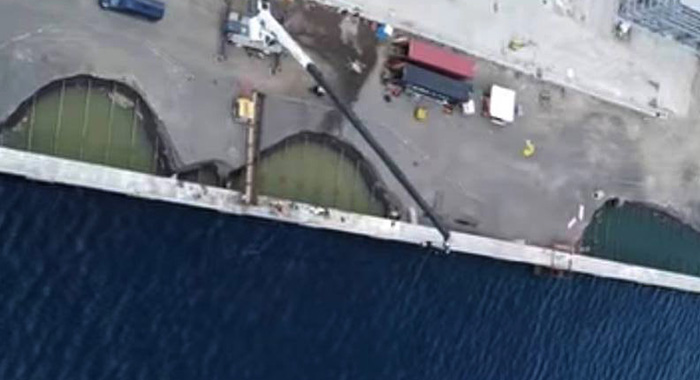Glenford Stewart, an engineer, did not say the depth to which the piles were currently driven
Former works minister Glenford Stewart, an engineer, has claimed that the sheet piles at the EC$600 million port being built in Kingstown are 40 feet too short, contributing to the loss of reclamation material at the site.
When questioned at the opposition New Democratic Party (NDP) press conference where he made the claim, Stewart, a former NDP senator, said his conclusions were based on his “calculations”.
He further did not say the depth to which the piles are driven, even amidst public discussion about the development at the port, which the government says is the second-most-expensive project in the nation’s history.
Stewart joined NDP President and Opposition Leader Godwin Friday and West Kingstown MP, Daniel Cummings, an engineer, to discuss the port project, photos of which have shown large pools of seawater inside the quay wall — the area where the sheet piles should have separated the port from the sea.
He criticised the construction method, noting that when Port Kingstown was built in the 1960s, engineers used rip rap protection — boulders to protect shoreline structures against the seawater — and built the pier on piles.
“It is placed there so that the sea waves coming in, when they arrive at that location, the wave energy will be dissipated,” Stewart said of the rip rap …
“The wharf areas, or the berthing areas, were constructed on piles, so that as the waves come, the waves will move and go towards the reclaimed area where the energy dissipated, and so the wharf areas, or the jetty areas, those are left intact, the waves do not destroy the jetty or the wharf on piles…”
However, with the new port, a dredge sucked up sand from the seabed along the east coast of St. Vincent and deposited it at the port site in Kingstown, after which sheet piles were used to separate the reclaimed area from the sea.
In February, it became public that some of those sheet piles had declutched, resulting in sand inside the reclaimed area being washed out to sea.

On March 5, Prime Minister Ralph Gonsalves said the declutching became apparent when dredging was being done outside of the sheet piles to ensure the berthing area was 40 feet deep.
He said that Aecon, the Canadian firm contracted to build the port, was pursuing “an industry-standard solution”, but the timeline for the remedial work had not been established yet.
On March 6, Minister of Seaports Senator Benarva Browne told Parliament that the completion date for the port had been revised from May 12 to Aug. 31.
She, however, said that the revised date resulted from the impact of Hurricane Beryl on July 1 last year.
Browne did not say anything about the likely impact of the loss of reclamation material because of the decoupling of metal sheets.
Then, in an update broadcast by state media on March 17, Tam Smith, project manager, Aecon Group Inc., when asked whether there were any challenges at the port, said:
“When we were doing the dredging to design depth on the front quay wall, we realised that some of the sheet piles had declutched but we have a repair methodology and that’s ongoing, and we don’t think at this point in time — it’s a bit early — but we don’t think it’s going to affect the schedule at all.”
The broadcast did not include any elaboration by Smith or questions by the reporter on the matter.
At the NDP press conference, Stewart said that Hurricane Beryl resulted in EC$30 million in damage at the port site.
He said the Canadian engineers who completed Port Kingstown around 1962 knew what they were doing.
“So, we must learn from experience, … he said, adding that based on his calculations, a new port could have been built at the current location for EC$200 million.
“I can tell you now that those sheet piles that were driven were driven 40 feet too short. They haven’t gone down deep enough,” he said of the piles at the new port that is being built.
“So how can you drive sheet piles in sand fill and come and excavate in front of the sheet piles so that you can get sufficient depth for the ships to berth? Total waste of time,” Stewart said.
He suggested that the wharf be built on piles going out to sea from the existing sheet pile landfill area.
Stewart further said the front of the sheet piles should have rip rap protection.
“Unless we do that, the next storm will see the end of this port. This is not a warning. This is a fact of life because we see it all over the world…
“Now, if you’re building on sand and you haven’t built them on piles that have sufficient depth, those buildings will only last a short while…
However, iWitness News was reliably informed that two sets of piles were used to make what is known as a combi-wall at the new port, with each sheet pile followed by a cylindrical pile.
Stewart questioned the alleged absence of the involvement of local engineers and architects in the project.
“When we are constructing huge projects of this kind, do we find our local people involved in the project? I would like to know which engineer from the Ministry of Transport and Works has been involved on the port,” he said at the press conference.
“We have buildings there as well. Which local architect has been involved in the project? We built the Argyle airport and we go along in the same manner, huge projects, but no local input. When something goes wrong, how do you maintain? No maintenance whatsoever. “
A source in the know has told iWitness News that Stewart’s company failed in two attempts to provide services at the new port.
“So, I’m warning the people of St. Vincent, not the government; I’m warning the people of St. Vincent and the Grenadines, come September, when we have the stormy weather, look and see what’s going to happen, unless we have a facility where the wave energy can be dissipated as they hit against the sheet piles…”
He said the first thing to be done is to drive the sheet piles to “the correct depth”.
“As I explained before, this project cannot be completed unless we have the protection of the sheet piles at the front so that the wave energy that hits the sheet piles will be dissipated at that point.”
He said the port “cannot be completed in August unless you have that protection of the sheet piles.
“Otherwise, everything there will be destroyed by that time. Wait, look and see. Let us learn from experience. You must protect it against the waves,” he said.







When you say Stewart company failed in providing services what do you mean? Did he tried to get a job there or he was given a job and couldn’t do it?